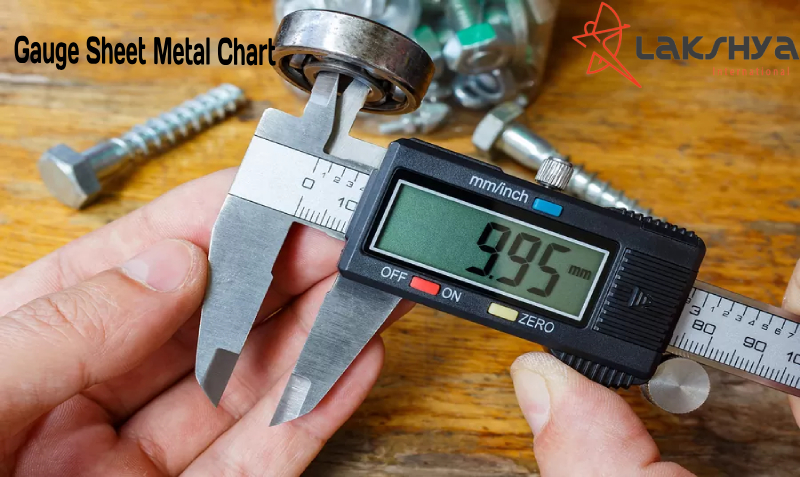When dealing with sheet metal, it is frequently referred to using the term “gauge.” Individuals who are unfamiliar with this gauge system may not grasp the significance of terms like “18 gauge steel.” To provide assistance, this blog post will elucidate the gauge system and include a comprehensive sheet metal gauge chart.
The gauge system is utilized to measure the thickness of sheet metal, expressed in terms of gauge numbers. For instance, if someone mentions “16 gauge thickness in mm,” they are referring to the thickness of the sheet metal measured in millimeters.
Understanding the gauge system is crucial when working with sheet metal. It allows you to determine the appropriate thickness for a particular application. Different gauge numbers correspond to varying thicknesses, with smaller gauge numbers indicating thicker sheets.
To convert gauge measurements to millimeters, you can use the “sheet metal gauge to mm” conversion. This conversion provides a convenient way to understand the precise thickness of a sheet based on its gauge.
A gauge sheet metal serves as a valuable reference tool. It visually presents the gauge numbers alongside their corresponding thicknesses in both gauge and millimeters. This chart simplifies the process of selecting the appropriate gauge for a specific project, ensuring the desired outcome and structural integrity.
How are Sheet Metal Gauges Used?
Gauges are employed to indicate the sheet metal thickness. These gauges are not standardized nor aligned with the metric system, and their values exist independently of these measurement systems. To accurately determine the gauges of steel thickness in inches or millimeters, one can refer to a gauge conversion chart. For instance, referring to such a chart, 18 gauge steel measures 0.0478 inch or 1.214 millimeters. It’s important to note that the gauge number, in this case, “18,” does not directly correspond to the actual measurements.
Today, various gauge systems are in use, each with specific gauge designations tailored to different types of metals. For example, in one gauge system, 18 gauge steel has a thickness of 0.0478 inches, while 18 gauge aluminum measures 0.0403 inches. These variations in thickness necessitate the use of a gauge chart to ensure the metal meets the required dimensions.
To further assist in understanding sheet metal thickness, it is valuable to consult a steel gauge thickness chart, sheet metal gauge chart, and a GI sheet size chart. These resources provide comprehensive information and visual representation of gauge numbers, corresponding thicknesses, and dimensions. By utilizing these charts, one can select the appropriate gauge and ensure the desired specifications are met for a particular project.
History of the Gauge System
The gauge system has a rich history in metal fabrication, believed to have originated in the British wire industry before the widespread adoption of standard and metric measurement systems. Initially, gauges were employed to denote the diameter of metal wire during the drawing process. Over time, this system became prevalent in designating the thickness of not only wire but also sheet metal.
Within this system, different gauge numbers correspond to specific thicknesses. For example, referring to the keywords provided, we have:
- 16 gauge thickness in mm: This indicates the thickness, measured in millimeters, of a sheet metal with a gauge number of 16.
- 14 gauge thickness in mm: Similarly, this denotes the thickness, in millimeters, of a sheet metal with a gauge number of 14.
- 12 gauge thickness in mm: This represents the thickness, measured in millimeters, of a sheet metal classified as 12 gauge.
- 10 gauge thickness in mm: Here, we refer to the thickness, in millimeters, of a sheet metal designated as 10 gauge.
- 20 gauge sheet in mm: Lastly, this term signifies the thickness, measured in millimeters, of a sheet metal possessing a gauge number of 20.
These gauge numbers provide a standardized system to communicate the wire and sheet metal thickness in mm, offering a convenient reference point for engineers, fabricators, and manufacturers. While the gauge system predates the establishment of standard and metric measurement systems, it has persisted as a widely recognized and utilized method for specifying thickness in the metalworking industry.
Sheet Metal Gauge Charts
To determine what metal gauge you need, use these sheet metal gauge charts:
Mild Steel Gauge Chart
Aluminum Gauge Chart
Stainless Steel Gauge Chart
Galvanized Steel Gauge Chart
Brass Gauge Chart
Copper Gauge Chart
| Mild Steel Gauge Chart* | ||
| GaugeNumber | Inches | MM |
| 7 | .1793 | 4.554 |
| 8 | .1644 | 4.175 |
| 9 | .1495 | 3.797 |
| 10 | .1345 | 3.416 |
| 11 | .1196 | 3.038 |
| 12 | .1046 | 2.656 |
| 14 | .0747 | 1.897 |
| 16 | .0598 | 1.518 |
| 18 | .0478 | 1.214 |
| 20 | .0359 | .911 |
| 22 | .0299 | .759 |
| 24 | .0239 | .607 |
| 26 | .0179 | .454 |
| 28 | .0149 | .378 |
Buy Mild Steel
| Aluminum Gauge Chart* | ||
| GaugeNumber | Inches | MM |
| 7 | .1443 | 3.665 |
| 8 | .1285 | 3.264 |
| 9 | .1144 | 2.906 |
| 10 | .1019 | 2.588 |
| 11 | .09074 | 2.305 |
| 12 | .08081 | 2.053 |
| 14 | .06408 | 1.628 |
| 16 | .05082 | 1.291 |
| 18 | .04030 | 1.024 |
| 20 | .03196 | .812 |
| 22 | .02535 | .644 |
| 24 | .02010 | .511 |
| 26 | .01594 | .405 |
| 28 | .01264 | .321 |
| 30 | .01003 | .255 |
Buy Aluminum
| Stainless Steel Gauge Chart* | ||
| GaugeNumber | Inches | MM |
| 8 | .17187 | 4.365 |
| 9 | .15625 | 3.968 |
| 10 | .14062 | 3.571 |
| 11 | .125 | 3.175 |
| 12 | .10937 | 2.778 |
| 14 | .07812 | 1.984 |
| 16 | .0625 | 1.587 |
| 18 | .050 | 1.270 |
| 20 | .0375 | .9525 |
| 22 | .03125 | .7937 |
| 24 | .025 | .635 |
| 26 | .01875 | .476 |
| 28 | .01562 | .396 |
| 30 | .0125 | .3175 |
Buy Stainless Steel
| Galvanized Steel Gauge Chart* | ||
| GaugeNumber | Inches | MM |
| 8 | .1681 | 4.269 |
| 9 | .1532 | 3.891 |
| 10 | .1382 | 3.510 |
| 11 | .1233 | 3.1318 |
| 12 | .1084 | 2.753 |
| 14 | .0785 | 1.9939 |
| 16 | .0635 | 1.6129 |
| 18 | .0516 | 1.310 |
| 20 | .0396 | 1.005 |
| 22 | .0336 | .853 |
| 24 | .0276 | .701 |
| 26 | .0217 | .551 |
| 28 | .0187 | .474 |
| 30 | .0157 | .398 |
Buy Galvanized Steel
| Brass Gauge Chart* | ||
| GaugeNumber | Inches | MM |
| 7 | .1443 | 3.665 |
| 8 | .1285 | 3.264 |
| 9 | .1144 | 2.906 |
| 10 | .1019 | 2.588 |
| 11 | .09074 | 2.305 |
| 12 | .08081 | 2.053 |
| 14 | .06408 | 1.628 |
| 16 | .05082 | 1.291 |
| 18 | .04030 | 1.024 |
| 20 | .03196 | .812 |
| 22 | .02535 | .644 |
| 24 | .02010 | .511 |
| 26 | .01594 | .405 |
| 28 | .01264 | .321 |
| 30 | .01003 | .255 |
Buy Brass
| Copper Gauge Chart* | ||
| GaugeNumber | Inches | MM |
| 7 | .180 | 4.572 |
| 8 | .165 | 4.191 |
| 9 | .148 | 3.759 |
| 10 | .134 | 3.404 |
| 11 | .120 | 3.048 |
| 12 | .109 | 2.769 |
| 14 | .083 | 2.108 |
| 16 | .065 | 1.651 |
| 18 | .049 | 1.245 |
| 20 | .035 | .889 |
| 22 | .028 | .711 |
| 24 | .022 | .559 |
| 26 | .018 | .457 |
| 28 | .014 | .356 |
| 30 | .012 | .305 |
Buy Copper
Buy Sheet Metal
What is the gauge of sheet metal?
The term “Gage” or “Gauge” refers to the numerical designation that represents the thickness and weight per square foot of a piece of sheet metal. The gauge values assigned to sheet metal range from 30 to 1, with higher numbers indicating thinner pieces of material.
What is 20-gauge sheet metal?
Upon examining these calculations, it becomes evident that 20-gauge mild steel possesses an approximate thickness of 0.3 inches or 0.76 millimeters. This thin yet sturdy material is ideal for a multitude of projects, offering both durability and versatility.
What is 12 gauge sheet?
The 12-gauge provides a minimum sheet thickness of 0.098 inches, whereas the 14-gauge offers a minimum sheet thickness of 0.070 inches. It is worth noting that the 12-gauge sheets are 40% heavier compared to the 14-gauge sheets. These variations in weight and thickness make the 12-gauge sheets suitable for applications involving dynamic pressure, while the 14-gauge sheets are specifically designed for static pressure scenarios.
What is the gauge size?
The thickness of a wire is denoted by its gauge. Each gauge is assigned a numerical value, where smaller numbers indicate thicker wire gauges, while higher numbers indicate thinner wires.
How many mm is 8 gauge?
For different materials of steel, the same gauge will also correspond to different mm.
Standard Steel: 8 Gauge = 4.176 mm
Stainless Steel: 8 Gauge = 4.191 mm
Aluminum, Brass, Copper: 8 Gauge = 4.115 mm
What is 10 gauge in mm?
Standard Steel: 10 Gauge = 3.416 mm
Galvanized Steel: 10 Gauge = 3.51 mm
Stainless Steel: 10 Gauge = 3.571 mm
Aluminum, Brass, Copper: 10 Gauge = 2.588 mm
What is 10 gauge in mm?
Standard Steel: 16 Gauge = 1.519 mm
Galvanized Steel: 16 Gauge = 1.613 mm
Stainless Steel: 16 Gauge = 1.588 mm
Aluminum, Brass, Copper: 16 Gauge = 1.29 mm




